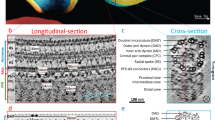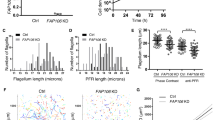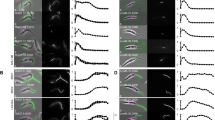Abstract
The 9 + 2 microtubule axoneme of flagella and cilia represents one of the most iconic structures built by eukaryotic cells and organisms. Both unity and diversity are present among cilia and flagella on the evolutionary as well as the developmental scale. Some cilia are motile, whereas others function as sensory organelles and can variously possess 9 + 2 and 9 + 0 axonemes and other associated structures1. How such unity and diversity are reflected in molecular repertoires is unclear. The flagellated protozoan parasite Trypanosoma brucei is endemic in sub-Saharan Africa, causing devastating disease in humans and other animals2. There is little hope of a vaccine for African sleeping sickness and a desperate need for modern drug therapies3. Here we present a detailed proteomic analysis of the trypanosome flagellum. RNA interference (RNAi)-based interrogation of this proteome provides functional insights into human ciliary diseases and establishes that flagellar function is essential to the bloodstream-form trypanosome. We show that RNAi-mediated ablation of various proteins identified in the trypanosome flagellar proteome leads to a rapid and marked failure of cytokinesis in bloodstream-form (but not procyclic insect-form) trypanosomes, suggesting that impairment of flagellar function may provide a method of disease control. A postgenomic meta-analysis, comparing the evolutionarily ancient trypanosome with other eukaryotes including humans, identifies numerous trypanosome-specific flagellar proteins, suggesting new avenues for selective intervention.
This is a preview of subscription content, access via your institution
Access options
Subscribe to this journal
Receive 51 print issues and online access
$199.00 per year
only $3.90 per issue
Buy this article
- Purchase on SpringerLink
- Instant access to full article PDF
Prices may be subject to local taxes which are calculated during checkout



Similar content being viewed by others
References
Afzelius, B. A. Cilia-related diseases. J. Pathol. 204, 470–477 (2004)
Sternberg, J. M. Human African trypanosomiasis: clinical presentation and immune response. Parasite Immunol. 26, 469–476 (2004)
Steverding, D. & Tyler, K. M. Novel antitrypanosomal agents. Expert Opin. Invest. Drugs 14, 939–955 (2005)
Robinson, D., Beattie, P., Sherwin, T. & Gull, K. Microtubules, tubulin, and microtubule-associated proteins of trypanosomes. Methods Enzymol. 196, 285–299 (1991)
Briggs, L. J., Davidge, J. A., Wickstead, B., Ginger, M. L. & Gull, K. More than one way to build a flagellum: comparative genomics of parasitic protozoa. Curr. Biol. 14, R611–R612 (2004)
Ostrowski, L. E. et al. A proteomic analysis of human cilia: identification of novel components. Mol. Cell. Proteomics 1, 451–465 (2002)
Padma, P. et al. Identification of a novel leucine-rich repeat protein as a component of flagellar radial spoke in the Ascidian Ciona intestinalis. Mol. Biol. Cell 14, 774–785 (2003)
Pazour, G. J., Agrin, N., Leszyk, J. & Witman, G. B. Proteomic analysis of a eukaryotic cilium. J. Cell Biol. 170, 103–113 (2005)
Smith, J. C., Northey, J. G., Garg, J., Pearlman, R. E. & Siu, K. W. Robust method for proteome analysis by MS/MS using an entire translated genome: demonstration on the ciliome of Tetrahymena thermophila. J. Proteome Res. 4, 909–919 (2005)
Avidor-Reiss, T. et al. Decoding cilia function: defining specialized genes required for compartmentalized cilia biogenesis. Cell 117, 527–539 (2004)
Li, J. B. et al. Comparative genomics identifies a flagellar and basal body proteome that includes the BBS5 human disease gene. Cell 117, 541–552 (2004)
Chodhari, R., Mitchison, H. M. & Meeks, M. Cilia, primary ciliary dyskinesia and molecular genetics. Paediatr. Respir. Rev. 5, 69–76 (2004)
Davy, B. E. & Robinson, M. L. Congenital hydrocephalus in hy3 mice is caused by a frameshift mutation in Hydin, a large novel gene. Hum. Mol. Genet. 12, 1163–1170 (2003)
Lorenzetti, D., Bishop, C. E. & Justice, M. J. Deletion of the Parkin coregulated gene causes male sterility in the quaking(viable) mouse mutant. Proc. Natl Acad. Sci. USA 101, 8402–8407 (2004)
Sun, Z. et al. A genetic screen in zebrafish identifies cilia genes as a principal cause of cystic kidney. Development 131, 4085–4093 (2004)
Moreira-Leite, F. F., Sherwin, T., Kohl, L. & Gull, K. A trypanosome structure involved in transmitting cytoplasmic information during cell division. Science 294, 610–612 (2001)
Bastin, P., Ellis, K., Kohl, L. & Gull, K. Flagellum ontogeny in trypanosomes studied via an inherited and regulated RNA interference system. J. Cell Sci. 113, 3321–3328 (2000)
Bastin, P., Sherwin, T. & Gull, K. Paraflagellar rod is vital for trypanosome motility. Nature 391, 548 (1998)
Hill, K. L. Biology and mechanism of trypanosome cell motility. Eukaryot. Cell 2, 200–208 (2003)
Woodward, R. & Gull, K. Timing of nuclear and kinetoplast DNA replication and early morphological events in the cell cycle of Trypanosoma brucei. J. Cell Sci. 95, 49–57 (1990)
Tam, L. W. & Lefebvre, P. A. The Chlamydomonas MBO2 locus encodes a conserved coiled-coil protein important for flagellar waveform conversion. Cell Motil. Cytoskeleton 51, 197–212 (2002)
Field, M. C. & Carrington, M. Intracellular membrane transport systems in Trypanosoma brucei. Traffic 5, 905–913 (2004)
Laemmli, U. K. Cleavage of structural proteins during the assembly of the head of bacteriophage T4. Nature 227, 680–685 (1970)
Altschul, S. F. et al. Gapped BLAST and PSI-BLAST: a new generation of protein database search programs. Nucleic Acids Res. 25, 3389–3402 (1997)
Liska, F. Selected genetic aspects of male infertility—what animal models tell us. Folia Biol. (Praha) 49, 129–141 (2003)
Wirtz, E. & Clayton, C. Inducible gene expression in trypanosomes mediated by a prokaryotic repressor. Science 268, 1179–1183 (1995)
Wickstead, B., Ersfeld, K. & Gull, K. Targeting of a tetracycline-inducible expression system to the transcriptionally silent minichromosomes of Trypanosoma brucei. Mol. Biochem. Parasitol. 125, 211–216 (2002)
Gadelha, C., Wickstead, B., de Souza, W., Gull, K. & Cunha-e-Silva, N. Cryptic paraflagellar rod in endosymbiont-containing kinetoplastid protozoa. Eukaryot. Cell 4, 516–525 (2005)
Sherwin, T. & Gull, K. The cell division cycle of Trypanosoma brucei brucei: timing of event markers and cytoskeletal modulations. Phil. Trans. R. Soc. Lond. B 323, 573–588 (1989)
Acknowledgements
We thank the genome centres, particularly GeneDB at the Sanger Institute, and our laboratory colleagues, especially S. Gordon and P. Taylor, for access to unpublished data and constructive discussions. This work was funded by the Biotechnology and Biological Sciences Research Council, the Wellcome Trust, the Royal Society and the Edward P. Abraham Trust. M.L.G. is a Royal Society University Research Fellow; K.G. is a Wellcome Trust Principal Research Fellow. Author Contributions The first six authors contributed equally to this work and are listed alphabetically. Individual contributions were as follows: R.B. proteomics and bioinformatic analysis; H.R.D. proteomics, bioinformatic and functional analyses; H.F. and S.G. functional analysis; S.R.H. proteomics; N.P. proteomics, bioinformatic and functional analyses.
Author information
Authors and Affiliations
Corresponding author
Ethics declarations
Competing interests
Reprints and permissions information is available at npg.nature.com/reprintsandpermissions. The authors declare no competing financial interests.
Supplementary information
Supplementary Notes 1
This file contains and introduction and preface to the Supplementary Information and the Supplementary Figure Legends. (DOC 23 kb)
Supplementary Methods
This file contains additional details of the methods used in this study. (DOC 47 kb)
Supplementary Notes 2
List of the key proteins in this study. (DOC 23 kb)
Supplementary Figure 1
The T. brucei Flagellar Proteome (TbFP): Table showing the proteins making up the TbFP with the number of unique peptides identifying each protein and the percentage sequence coverage this represents. Predicted protein characteristics and comparative bioinformatics conducted against an informative set of model organisms are also shown. (PDF 150 kb)
Supplementary Figure 2
Ciliary disease genes and in the TbFP a. Table showing TbFP proteins with an associated human homologue that has been shown to be the causative agent of a disease with known ciliary links. b. Candidate human disease genes in the TbFP (PDF 24 kb)
Supplementary Figure 3
Flagellar motility is essential for bloodstream trypanosomes. Table summarizing the phenotypes observed from biological validation of the TbFP by RNAi of bloodstream form trypanosomes. Transmission EMs showing phenotypes of RNAi-induced PFR2, MBO2, DIGIT and TAX1 in bloodstream form trypanosomes. (PDF 93 kb)
Supplementary Figure 4
Analysis by tomato lectin and VSG antibody shows that the pocket is functional to varying degrees in PFR2 RNAi-induced bloodstream form cells. Immunofluorescence images showing flagellar pocket functionality in bloodstream form PFR2 RNAi-induced cells. (PDF 2621 kb)
Rights and permissions
About this article
Cite this article
Broadhead, R., Dawe, H., Farr, H. et al. Flagellar motility is required for the viability of the bloodstream trypanosome. Nature 440, 224–227 (2006). https://doi.org/10.1038/nature04541
Received:
Accepted:
Issue date:
DOI: https://doi.org/10.1038/nature04541
This article is cited by
-
Genome-wide subcellular protein map for the flagellate parasite Trypanosoma brucei
Nature Microbiology (2023)
-
In silico evolutionary and structural analysis of cAMP response proteins (CARPs) from Leishmania major
Archives of Microbiology (2023)
-
Zinc finger myeloid Nervy DEAF-1 type (ZMYND) domain containing proteins exert molecular interactions to implicate in carcinogenesis
Discover Oncology (2022)
-
Gene co-expression network analysis of Trypanosoma brucei in tsetse fly vector
Parasites & Vectors (2021)
-
CFAP45 deficiency causes situs abnormalities and asthenospermia by disrupting an axonemal adenine nucleotide homeostasis module
Nature Communications (2020)



